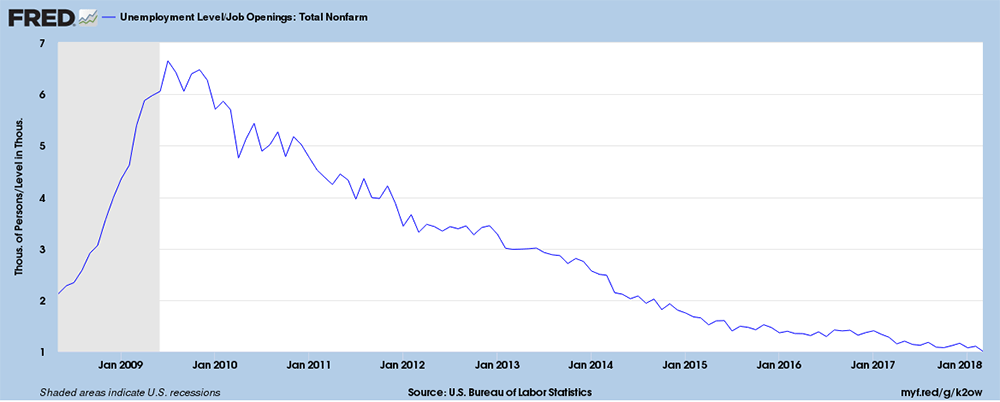Desperately Seeking Workers
With roughly equal numbers of open jobs and unemployed people, companies are scrapping their talent plans and looking for workers wherever they can find them.
In late May, a viral story neatly captured the zeitgeist. Michael Rotondo, a 30-year-old Syracuse-area man who refused to leave his parents’ home where he had lived for eight years without paying rent, sued his mom and dad after they tried to evict him. It was the proverbial entitled-millennial-refusing-to-grow-up story.
But what happened next is also part of the zeitgeist. Villa Italian Kitchen, an international chain, offered Rotondo a job with a US$1,101 signing bonus.
It could have been a publicity stunt, of course. But the fact that a large corporation made an unsolicited job offer — with a bonus, no less — to a person who seemed to set out to prove himself feckless in the eyes of the world is also a very 2018 story. It is one of the most significant economic realities of the moment — and one that company leaders have yet to fully recognize — that the U.S. economy is chronically short of people to take jobs.
Automation may be coming to disrupt traditional employment, but it isn’t coming nearly fast enough. After nine years of economic growth and 91 straight months of payroll gains, the unemployment rate has fallen to 3.9 percent. Employers in all types of industries — trucking, Chesapeake Bay crab processing, restaurants, plumbing — are reporting significant worker shortages.
If there’s one chart that highlights the situation, it is this one below, which tracks the ratio of unemployed people (i.e., people who want jobs but don’t have them) to the number of jobs open in the U.S. Both figures are tallied monthly by the Bureau of Labor Statistics. The tale it tells is one of first joy, and then challenges and difficulty, and, now, futility and trauma for the nation’s employers.
In 2009 and 2010, after companies responded to the Great Recession by firing people and reducing payrolls with alacrity, the U.S. labor market was a buyer’s market. In July 2009, with 6.65 unemployed people for each opening, there were legions of highly experienced, highly skilled, and highly motivated people on the sidelines. Employers could hire MBAs to work as baristas, Ph.D.s to work as tutors, and construction managers to work odd jobs. Because people were grateful for work, they would be happy to take the job at the wages on offer. Employers were like children in a candy store where everything was on sale at a 30 percent discount.
But things have evolved the way Ernest Hemingway said people go bankrupt — “gradually, then suddenly.” Over the past eight years of steady growth, the number of jobs available rose consistently and the number of unemployed people fell just as consistently — which pushed the unemployed-to-job openings ratio down just as consistently. At the end of March 2018, there were a record 6.55 million jobs open in the U.S. and just 6.585 million unemployed people. And so the ratio was a meager 1.005 to one.
Now, in the years when the ratio was declining, employers generally remained in the driver’s seat, with unemployed people competing for openings. Through 2015, employers were, by and large, able to find the people with the skills they wanted without having to raise wages much. The candy store remained open, although the size of the discount declined.
But something has changed in the past couple years, and especially in the past year. As the ratio approaches one (and threatens to fall below that level), conditions are changing in several significant ways.
First, there simply aren’t that many people on the sidelines. It’s simplistic, and probably inaccurate, to note that everybody who wants a full-time job in the U.S. has one. To be sure, many people do remain unemployed, and millions more remain underemployed. But the data suggest that, compared with several years ago, there are far, far fewer people sitting on the bench waiting to get back onto the playing field.
Second, employers increasingly have to compete with one another for available people to fill positions, rather than the other way around. They can’t expect to have their pick of appropriately qualified (or even overqualified) individuals.
Automation may be coming to disrupt traditional employment, but it isn’t coming nearly fast enough.
Third, given the paucity of job-seekers, it means the biggest (and possibly the only) source of employees will be people who already have jobs. And to convince someone to walk across the street, you have to construct an offer that is more compelling than the one she already has: better wages, benefits, working conditions, and advancement prospects. Further, people who have jobs in which they are increasingly secure (given the low unemployment rate) are more likely to summon up the gumption to make greater demands of their employers.
Fourth, the new climate means being more opportunistic and flexible about staffing. When the ratio of unemployed to open jobs stands at parity, it means that the short-term people strategy, talent plan, human capital initiative — whatever you want to call it — that was devised in 2012 or 2015 is no longer fit for purpose. And so employers may have to do things that were simply unthinkable in 2009 or 2010: providing paid on-the-job training, raising wages sharply, offering to find housing for prospective employees, or jacking up perks and benefits. Or using social media to offer a signing bonus to a 30-year-old guy whose parents are trying to evict him.







